Understanding Database Types: When to Use What
 Usman Soliu
Usman SoliuTable of contents
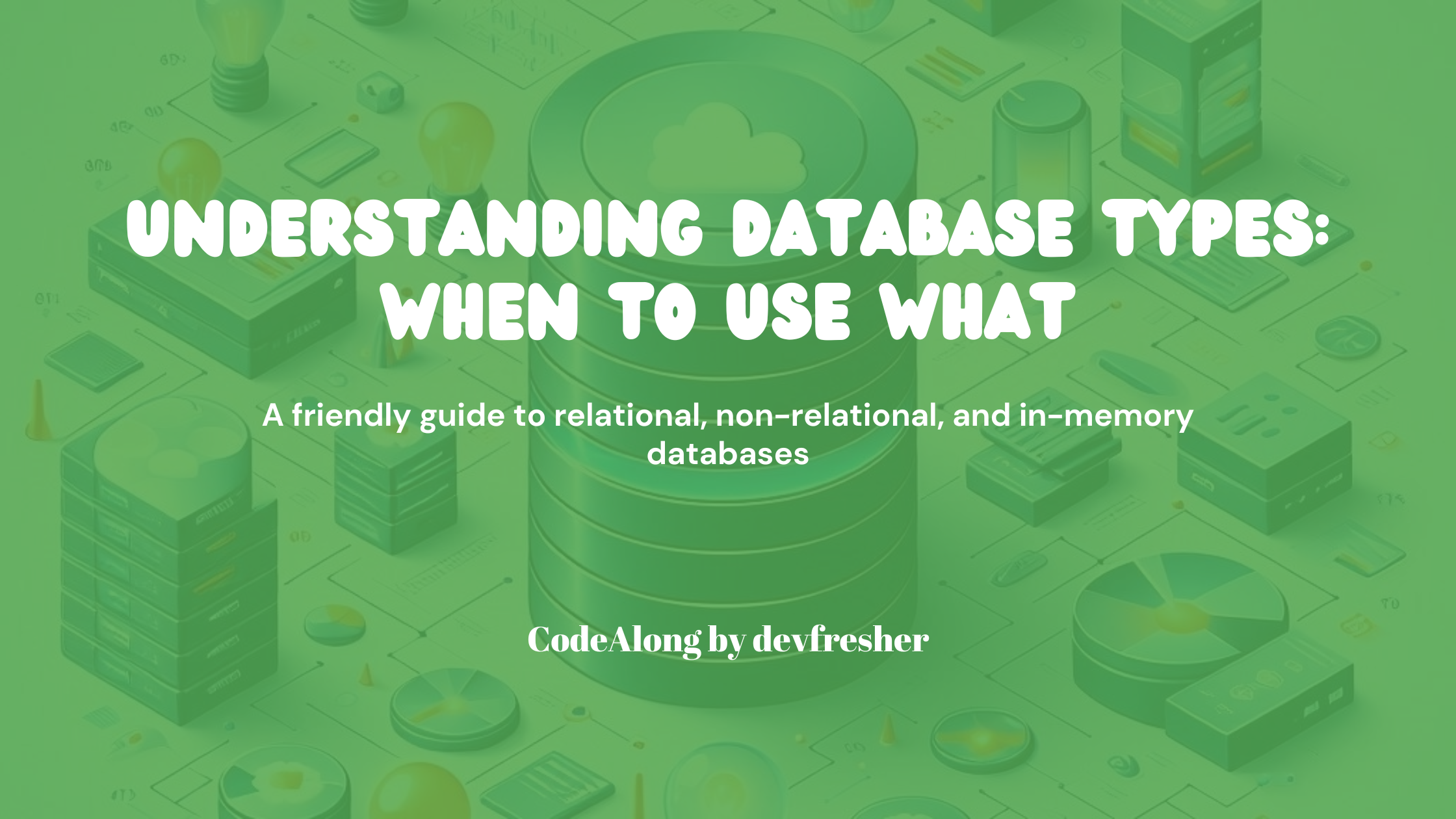
Let me tell you a quick story. A team of developers launches a fitness app, and within the first month, it skyrockets to 10,000 users. Everything seems perfect right? …Great! until the app starts slowing down, users complaining, workouts fail to save, and frustration builds.
The problem? The database wasn’t designed to handle real-time tracking from thousands of concurrent users. Instead of celebrating their success, the team scrambles for days, migrating to a better-suited system.
This scenario is more common than you might think. Choosing the right database isn’t just a technical decision—it directly impacts performance, scalability, and even your team's stress levels.
In this article, we'll explore the major database types in a way that's easy to understand. With real-world examples, you'll gain a clear framework for making database decisions that scale with your need
The Database Family Tree
Before diving into details, let's get a bird's-eye view of our options:
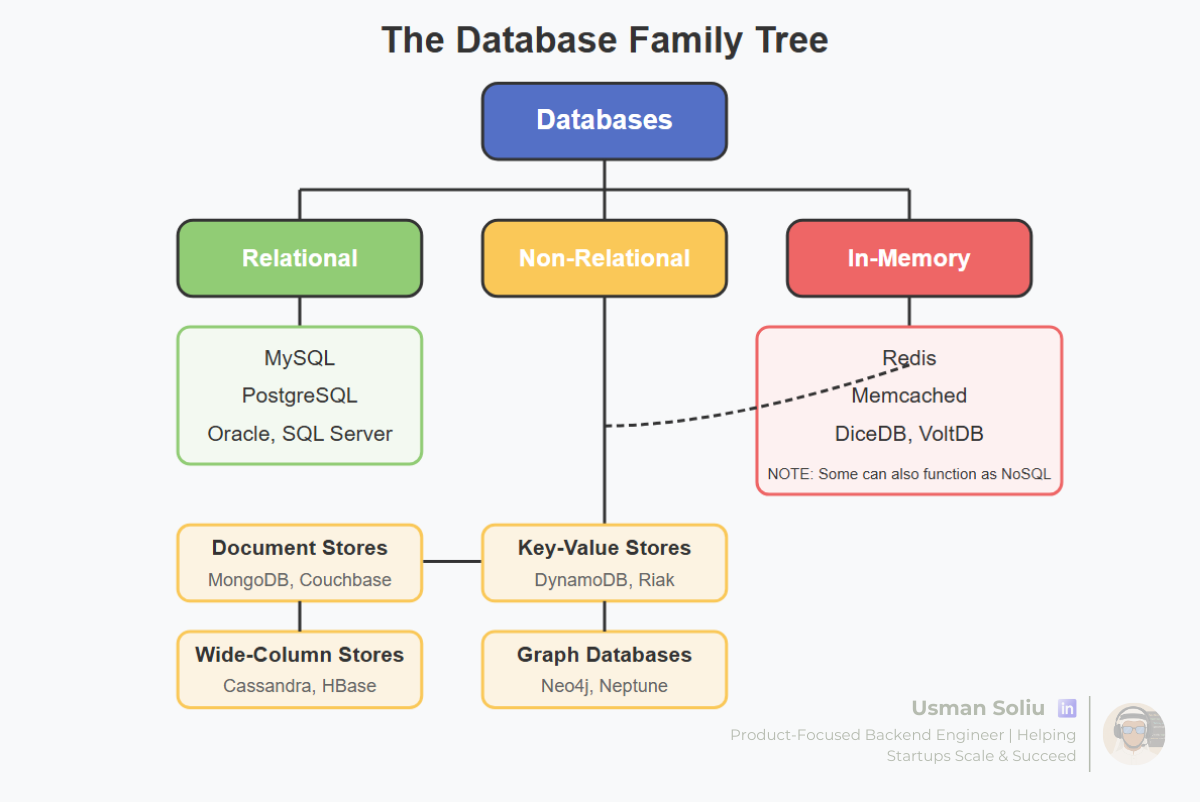
Relational databases: The traditional organized filing cabinets (MySQL, PostgreSQL)
Non-relational (NoSQL) databases: The flexible specialists, including:
Document stores (MongoDB, Couchbase)
Key-value stores (DynamoDB, Riak)
Wide-column stores (Cassandra, HBase)
Graph databases (Neo4j, Amazon Neptune)
In-memory databases: The speed demons (Redis, Memcached)
Each family exists because it solves specific problems better than the others. None is universally "best"—it's all about matching the right tool to your particular needs.
Relational Databases: The Reliable Workhorses
What They Are
Imagine a collection of spreadsheets (tables) with strict relationships between them. Customer information in one table connects to orders in another via customer IDs. Every piece of data has its designated place, and there are rules to keep everything consistent. Think of it like a library where every book has exactly one correct shelf location, with a detailed catalog system ensuring you can find anything quickly

When They Shine
Relational databases excel when your data is structured, relationships are clear, and data integrity is non-negotiable.
Real-world example: Shopify powers millions of e-commerce stores using MySQL. When a customer places an order, multiple tables update simultaneously: inventory decreases, order history updates, payment processes, and customer information links to the new order. All of these operations must succeed or fail together—something relational databases handle beautifully through transactions.
Another example: Bank of America uses Oracle to process financial transactions. When you transfer money, the bank must guarantee that the amount is deducted from one account and added to another—no exceptions. Relational databases provide ACID guarantees (Atomicity, Consistency, Isolation, Durability) that make this reliability possible.
When They Struggle
Despite their strengths, relational databases face challenges when:
Data doesn’t fit neatly into tables
Schema changes frequently
Horizontal scaling is needed across many servers
Extremely high write speeds are required
For example: Facebook originally used MySQL for everything but found it couldn't handle the complex, interconnected nature of a social graph at scale. The company eventually developed custom solutions, including graph databases for relationship data, because relational systems struggled with queries like, "Show all posts from friends of friends who live in Lagos Nigeria and like biking."
Popular Options
PostgreSQL: Open-source, feature-rich, excellent for complex queries
MySQL: Fast, reliable, and widely supported
Oracle: Enterprise-grade with advanced features (and a price tag to match)
Microsoft SQL Server: Deep Windows/Microsoft ecosystem integration
Non-Relational (NoSQL) Databases: The Flexible Specialists
NoSQL databases emerged to solve problems where relational databases struggled. Rather than offering one-size-fits-all solutions, they provide specialized tools for specific data patterns.
Document Stores
What They Are: Collections of JSON-like documents where each document contains all relevant information about an entity.
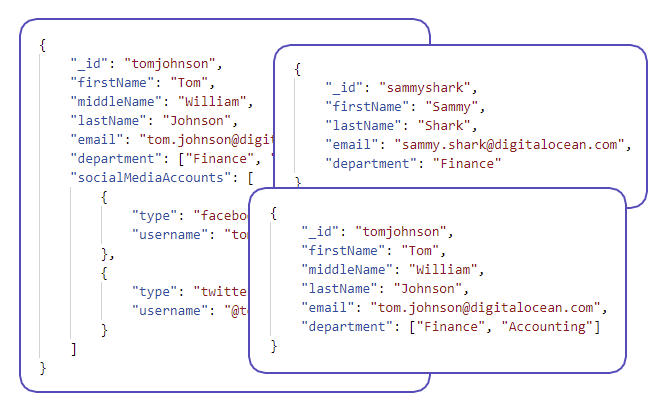
Real-world example: The New York Times uses MongoDB to store articles and related content. Each article document contains the text, author info, related images, tags, and comments—everything needed to render that article. This approach makes it incredibly fast to retrieve and display complete articles without joining multiple tables.
When They Shine: Content management, catalogs, user profiles, and any scenario where data items make natural "documents."
Key-Value Stores
What They Are: Simple databases that store values associated with keys, similar to a giant dictionary.
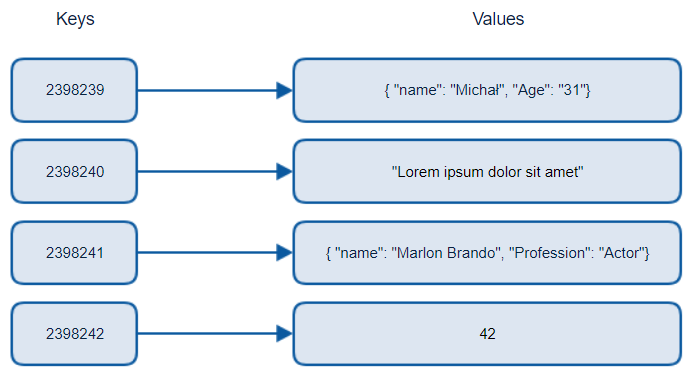
Real-world example: Lyft uses Amazon DynamoDB to track driver locations in real-time. With millions of location updates per minute, they need blazing-fast writes and simple lookups by driver ID. The key-value model perfectly matches this pattern.
When They Shine: Session storage, user preferences, shopping carts, and scenarios requiring simple, high-speed lookups.
Wide-Column Stores
What They Are: Databases that store data in columns rather than rows, allowing for massive scalability across distributed systems.

Real-world example: Netflix uses Apache Cassandra to store and process viewer activity data. With 200+ million subscribers generating viewing events constantly, they need something that scales horizontally across hundreds of servers while handling enormous write loads. Cassandra’s column-oriented design makes it possible to add more servers as demand grows.
When They Shine: Time-series data, event logging, and high-volume write scenarios requiring massive scale.
Graph Databases
What They Are: Specialized databases that excel at representing and querying complex relationships.
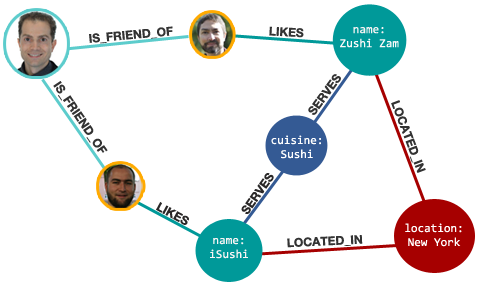
Real-world example: LinkedIn's connection network runs on graph technology. When you see "3rd-degree connection" or receive suggestions for "people you may know," that’s a graph database efficiently traversing relationship paths that would require expensive joins in a relational database.
When They Shine: Social networks, recommendation engines, fraud detection, and knowledge graphs.
In-Memory Databases: The Speed Demons
What Makes Them Special:
Most databases primarily store data on disk, reading it into memory as needed. In-memory databases flip this model by keeping everything in RAM, making them dramatically faster—often by 100x or more.
Real-World Examples:
Twitter/X uses Redis to cache user timelines and handle millions of requests per second with sub-millisecond latency. When you refresh your timeline, you're likely seeing data served from Redis rather than hitting their main databases.
Airbnb uses Redis to power their search autocomplete. When you start typing "New Yo..." and instantly see "New York" suggestions, that's Redis responding in real-time.
When They Shine
In-memory databases excel when:
Speed is critical (e.g., trading platforms, gaming leaderboards)
Data access patterns are predictable
You need simple operations at massive scale
Caching frequently accessed data would improve performance
When They Struggle
The tradeoffs come with:
Limited capacity (RAM is expensive compared to disk storage)
Persistence challenges (though many now offer persistence options)
Data recovery after crashes (some in-memory data may be lost)
Making the Decision: A Practical Framework
When choosing a database, ask yourself these questions:
What's your data structure? Tabular with clear relationships → Relational; Nested or variable structure → Document; Simple values → Key-value; Complex relationships → Graph
What are your consistency needs? Strong consistency for financial or critical data → Relational; Eventual consistency acceptable → Many NoSQL options
What's your scale? Will you need to scale horizontally across many machines? Many NoSQL databases make this easier.
What are your query patterns? Complex joins and aggregations → Relational; Simple lookups by ID → Key-value; Relationship traversal → Graph
Hybrid Approaches
Most mature companies use multiple database types together:
Uber combines PostgreSQL for financial data and MySQL for transaction records, with Redis for real-time data like driver locations, and Cassandra for trip data requiring massive scale.
Airbnb uses MySQL for core booking data, Elasticsearch for searching listings, Redis for caching and real-time features, and Apache Druid for analytics.
Case Study: Evolution of Database Architecture
Let’s follow the journey of an imaginary fitness app as it scales:
Stage 1: MVP (1,000 users)
A single PostgreSQL database handles everything: user accounts, workout data, social features
Simple architecture gets the product launched quickly
Stage 2: Growth (50,000 users)
Added Redis for caching frequently accessed data
Still using PostgreSQL as the system of record
Response times improve, but database load during peak hours is concerning
Stage 3: Scaling (500,000 users)
Workout time-series data moved to MongoDB for better handling of variable workout structures
User graph (followers, friends) moved to Neo4j for better performance on social features
PostgreSQL still handles accounts, payments, and subscriptions
Redis expanded for real-time features like "users working out now"
Stage 4: Enterprise (5+ million users)
Time-series workout data migrated from MongoDB to Cassandra for better horizontal scaling
Redis Cluster implemented for distributed caching
PostgreSQL sharded by user region
Conclusion: The Right Tool for the Right Job
Choosing the right database isn’t about finding a perfect solution but understanding the strengths of each option. Relational databases are great for consistency, NoSQL excels with flexible, scalable data, and in-memory databases shine when speed is needed.
The fitness app team learned this the hard way. What began as a simple database soon became a bottleneck as the app grew. Reflecting on their experience, they realized they wouldn’t have faced that painful migration if they had understood their options from the start.
Six months later, their app supported 100,000 users with a hybrid system—PostgreSQL for user data, Redis for real-time features, and a time-series database for workout metrics. Their journey reinforced that there’s no one-size-fits-all database.
Now, with this knowledge, you can make informed choices based on your needs and growth. Start simple, but design with flexibility to scale. The right database lets you focus on building great features, not firefighting performance issues.
Subscribe to my newsletter
Read articles from Usman Soliu directly inside your inbox. Subscribe to the newsletter, and don't miss out.
Written by

Usman Soliu
Usman Soliu
Usman Soliu, a seasoned software engineer with a career spanning over six years, has devoted more than three years to constructing robust backend applications. Beyond the corporate sphere, he actively contributes to open-source projects, showcasing a commitment to collaborative innovation.